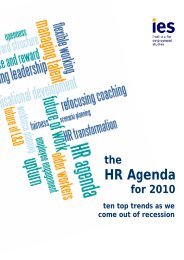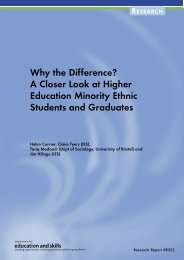Post-16 Transitions: a Longitudinal Study of Young People with ...
Post-16 Transitions: a Longitudinal Study of Young People with ...
Post-16 Transitions: a Longitudinal Study of Young People with ...
Create successful ePaper yourself
Turn your PDF publications into a flip-book with our unique Google optimized e-Paper software.
Table 6.3: Type <strong>of</strong> support lost since Year 11<br />
N = %<br />
Learning/educational support/special tuition 54 18<br />
SEN tutor contact/teacher support 49 17<br />
One to one tuition/mentoring/individual help 47 15<br />
Speech therapy 39 11<br />
All support has been lost 18 6<br />
Physiotherapy 14 4<br />
Contact/support <strong>of</strong> school 12 4<br />
Social worker support/access to support services 12 4<br />
Counselling/emotional support 11 4<br />
Career guide support 7 3<br />
Help <strong>with</strong> exams 5 2<br />
Close liaison <strong>with</strong> SENCO/SENCO support 5 2<br />
Transport 5 1<br />
Respite care 5 1<br />
Help <strong>with</strong> Dyslexia 4 2<br />
Removal <strong>of</strong> statement meant less/no support 4 1<br />
Lap tops/IT back up 4 1<br />
Other 39 13<br />
N = 302<br />
Note: All percentages are weighted percentages, unless otherwise stated<br />
Source: IES/MORI 2003<br />
• lowered motivation<br />
• fewer educational opportunities, and a<br />
• loss <strong>of</strong> confidence and self-esteem.<br />
More surprisingly though, one in twenty parents and carers<br />
reported that the loss <strong>of</strong> support post-<strong>16</strong> had actually led to<br />
increased independence for the young person.<br />
In addition to the support that had been lost since Year 11,<br />
many parents and carers (19 per cent) also reported that new<br />
support had subsequently become available (Table 6.5). This<br />
suggests that there was a net gain in support (albeit possibly <strong>of</strong><br />
a different sort) since compulsory schooling came to an end.<br />
The most common types <strong>of</strong> support that had become available<br />
post-<strong>16</strong> included:<br />
• special educational need(s) support from colleges<br />
<strong>Post</strong>-<strong>16</strong> <strong>Transitions</strong> <strong>of</strong> <strong>Young</strong> <strong>People</strong> <strong>with</strong> SEN: Wave 2 95

















